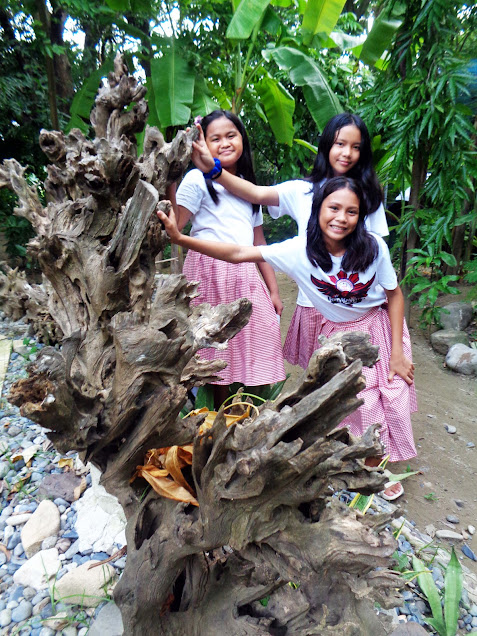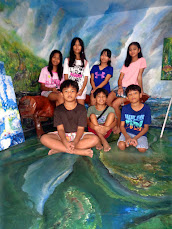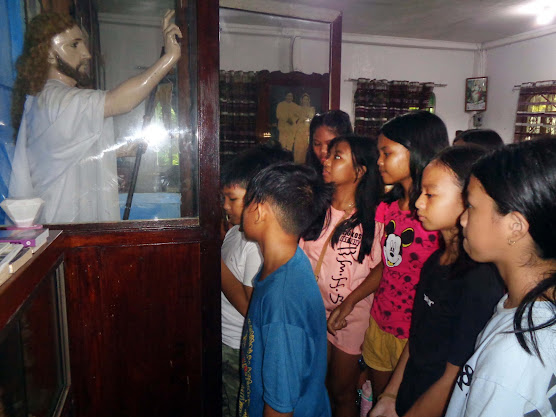Our Town's Landmark and Heritage
San Vicente, Ilocos Sur
Heritage Zone of the North RA 11645
Dr Abe V Rotor
1. 18th Century Basi Wine Cellar
Late 18th Century Basi wine cellar retains the original brick walls and wooden structure made of hard wood. The jars are original as well, and have been in use through the years in brewing and aging of basi, and lately, different table wines from local fruits. Students from SVIS are full of awe and wonder at the old trade and technology of basi and vinegar making during their study tour, with the guidance of the author as in-charge of the project.
Top photos, products are bottled and labelled, displayed and marketed on a limited scale. Lower photos: hermetically sealed jars await 2 to 5 years of aging (10 years on special occasions). SVIS students delight in examining the specimens, eager in learning about the indigenous industry.
2. Art Gallery
"If you have a garden and a library, you have everything you need."
– Cicero
Heritage tree of three generations - native mango (Mangifera indica) is host
to viny plants, ferns, and lianas like Rosary Pea and Philodendron
Shrine of national hero, Dr Jose Rizal in exile at Dapitan. Right, coed poses with a Heliconia flower with the bust of Emilio Aguinaldo, first president of the First Republic of the Philippines, at the background. Both heroes, other than their deeds in liberating the country from foreign colonization, are known for their love and care for the environment.
Arboretum or Miniature Tropical Rainforest
As miniature replica, the Center maintains the three-storey distinct
structure of a tropical rainforest, namely, underbrushes, canopy layer,
and emergents, cum epiphytes and lianas, as virtual field laboratory
in forestry and ecology, and other related fields of study.
An arboretum is an outdoor living tree museum. A garden is a planned plot of land adjoining a house for cultivating plants, flowers and fruits, and other forms of nature.
4. Museum and Library
"Books last longer than the computer
in mind, heart and spirit." - avr
Students from San Vicente Integrated School pay homage to the icon of
the Risen Christ, at he LWNC Museum and Library.
Left, a curious SVIS grader examines a wooden head of a Philippine deer,
a wildlife species now at the brink of extinction in the Ilocos Region.
Right, a SVIS coed sits on an antique "Cleopatra" reclining chair made
by local artisan.
First published in 1934, Bannawag is widely regarded as "Bible of the North." It reaches the heart Northern Luzon, as well as Visayas, Mindanao, and Ilocano communities in Hawaii and America's West Coast. Bannawag highlights family values in its stories and articles and through the years, has continued to inspire, entertain, and empower its readers.


"Build a home library where knowledge grows into wisdom." - avr
5. School-on-Air, Research & Workshop
School-on-Air: avrotor.blogspot.com
Radio broadcast TATAKalikasan Ateneo de Manila University,
and Usapang Bayan
ANNEXES
Living with Nature Center (Concept and Thrusts)
San Vicente, Ilocos Sur
Linked with Website avrotor.blogspot.com LIVING WITH NATURE; Book Series: Living With Nature (5 volumes), Bannawag Okeyka Apong Column. TATAKalikasan Ateneo de Manila University 87.9 fm Radyo Katipunan, and Usapang Bayan
San Vicente Integrated School Teachers at Dr Abe V Rotor's Family
Residence in Poblacion, San Vicente, Ilocos Sur
Ilocos Vinegar
Livelihood Projects
2. Art Gallery
Nature's Art
Nature's Art
Cyptobiology
Ethnic Art
Mural Paintings
Contemporary & modern paintings
4. Museum & Library
Indigenous articles, artefacts
Exhibits, and displays by occasion
Holy Icons (The Risen Christ)
Book Collection
Journals and Periodicals collection
Ethnic Art
Mural Paintings
Contemporary & modern paintings
3. Arboretum, EcoSanctuary & Garden
Biodiversity
Heritage Trees
Natural Farming
Tri-commodity Farming
Biodiversity
Heritage Trees
Natural Farming
Tri-commodity Farming
Shrines (Jose Rizal, Apo Baket, etc)
4. Museum & Library
Indigenous articles, artefacts
Exhibits, and displays by occasion
Holy Icons (The Risen Christ)
Book Collection
Journals and Periodicals collection
5. School-on-Air, Research & Workshop
Multi-Intelligence Development
Humanities, Integrated Art
On-site and Hands-on Study
Multi-Intelligence Development
Humanities, Integrated Art
On-site and Hands-on Study
Thesis and Dissertation, Studies
Workshops, by sector/topic
Workshops, by sector/topic
6. Internet: Living with Nature avrotor.blogspot.com and Naturalism - the Eighth Sense with 6,000 published articles to present. Accessible worldwide on the Internet.
May 2015 National Heritage Month*
In May 2015, the Philippines celebrated National Heritage Month (NHM), which is an annual observance in the month of May. NHM, established by Presidential Proclamation No. 439, aims to foster awareness, respect, and love for the nation's culture and history among Filipinos. The theme for NHM 2015 was likely related to preserving cultural heritage and the role of communities in its preservation, as seen in the theme for the following years.
While the specific activities and events for NHM 2015 are not detailed in the provided search results, it's likely that the celebration involved various activities aimed at promoting Filipino culture and heritage, such as:
Community-based initiatives:
Encouraging communities to participate in the preservation of their local heritage through cleanup drives, planting trees, and highlighting local traditions.
Highlighting National Artists:
The National Commission for Culture and the Arts (NCCA) and other cultural organizations may have organized events to honor and celebrate National Artists and their contributions to the nation's artistic and cultural landscape.
Museum visits and exhibitions:
Museums and cultural institutions may have offered special exhibitions and programs to showcase Philippine history and culture.
Educational programs:
Schools and educational institutions may have organized lectures, seminars, and workshops to educate students about Philippine heritage.
Public awareness campaigns:
Government agencies and cultural organizations may have launched public awareness campaigns to raise public awareness about the importance of preserving national heritage.
It's worth noting that the National Heritage Month is a continuous celebration, with each year's theme and activities focusing on different aspects of Filipino heritage and its preservation. The NHM celebrations in 2015 were likely a continuation of this tradition, with a focus on empowering communities and highlighting the value of cultural heritage in building a sustainable future. AI Overview
While the specific activities and events for NHM 2015 are not detailed in the provided search results, it's likely that the celebration involved various activities aimed at promoting Filipino culture and heritage, such as:
Community-based initiatives:
Encouraging communities to participate in the preservation of their local heritage through cleanup drives, planting trees, and highlighting local traditions.
Highlighting National Artists:
The National Commission for Culture and the Arts (NCCA) and other cultural organizations may have organized events to honor and celebrate National Artists and their contributions to the nation's artistic and cultural landscape.
Museum visits and exhibitions:
Museums and cultural institutions may have offered special exhibitions and programs to showcase Philippine history and culture.
Educational programs:
Schools and educational institutions may have organized lectures, seminars, and workshops to educate students about Philippine heritage.
Public awareness campaigns:
Government agencies and cultural organizations may have launched public awareness campaigns to raise public awareness about the importance of preserving national heritage.
It's worth noting that the National Heritage Month is a continuous celebration, with each year's theme and activities focusing on different aspects of Filipino heritage and its preservation. The NHM celebrations in 2015 were likely a continuation of this tradition, with a focus on empowering communities and highlighting the value of cultural heritage in building a sustainable future. AI Overview
----------------------------
Annex
About San Vicente, Ilocos Sur
Living with Nature Center
San Vicente, officially the Municipality of San Vicente (Ilocano: Ili ti San Vicente; Filipino: Bayan ng San Vicente), is a municipality in the province of Ilocos Sur, Philippines. According to the 2020 census, it has a population of 13,118 people.
Etymology
The municipality's name came from the name of Saint Vincent Ferrer, whose winged statue was found inside a box entangled in fishing nets. The fishermen consulted this matter to the friars in Villa Fernandina (now Vigan), who identified the person depicted by the statue. The statue was carried to the town's center, where a church was built. From then on, the town formerly known as Tuanong (sometimes called Taonan) was renamed San Vicente.
History
In tracing the history of San Vicente, one always has to start from Vigan. Vigan was established by the Spanish conquistador, Juan de Salcedo on June 13, 1573.
Upon Salcedo's return in 1574, he brought with them the Augustinian friars in order to proselytize Christianity among the inhabitants. After Salcedo's death on March 11, 1576, Franciscan friars replaced the Augustinians in 1579. These same friars spread up to San Vicente to convert the people to the Catholic faith.
Up until 1582, there were only about 800 residents in Vigan. In 1591, Vigan began to organize its government, which included the barrios of Tuanong, Santa Catalina de Baba, and Caoayan. There were then a population numbering about 4,000 inhabitants at this time.
Between the years 1720 and 1737, the first chapel of Barrio Tuanong was erected. Later in 1748, the Confraternity of Jesus of Nazareth was organized. In one record of the Vigan Convent archives, a funeral that took place on January 29, 1748 in the chapel of Barrio Tuanong was recorded. Two chaplains, Don Agustin de la Encarnacion and Don Pedro Geronimo de Barba, were the priests of the chapel in that year. It is believed that the chapel is the first stone building that one sees upon entering the San Vicente Central School from the main road.
On June 16, 1751, the chaplain was Don Miguel de Montanez. He was the first priest there and also in the then newly constructed chapel of San Sebastian.
Difficulties in reaching Barrio Tuanong and Barrio Santa Catalina de Baba from Vigan especially during the months of June to October were experienced due to the absence of a dike or bridge. Priests from Vigan reached these areas by means of a raft. The problem prompted the separation of these two barrios from Vigan in 1793.
In 1795, the seat of the municipality and the church in Barrio Tuanong were inaugurated, and the town became known as San Vicente. Don Pedro de Leon was the first parish priest and he was believed as the initiator of the construction of the Church of San Vicente.
Geography
San Vicente is situated 3.33 kilometres (2.07 mi) from the provincial capital Vigan, and 405.53 kilometres (251.98 mi) from the country's capital city of Manila.
Barangays
San Vicente is politically subdivided into 7 barangays. Each barangay consists of puroks and some have sitios.
Demographics
Population census of San Vicente
YearPop.±% p.a.
1903 5,060 —
In the 2020 census, San Vicente had a population of 13,118. The population density was 1,000 inhabitants per square kilometre (2,600/sq mi).
Economy
The municipality is known for its production of beautiful furniture made from narra and other tropical hardwoods, even from old wood previously used in wooden sugarcane crushers and old houses to make reproduction antiques.
Government
San Vicente, belonging to the first congressional district of the province of Ilocos Sur, is governed by a mayor designated as its local chief executive and by a municipal council as its legislative body in accordance with the Local Government Code. The mayor, vice mayor, and the councilors are elected directly by the people through an election which is being held every three years.
Education
The San Vicente Schools District Office governs all educational institutions within the municipality.
Primary and elementary schools
Etymology
The municipality's name came from the name of Saint Vincent Ferrer, whose winged statue was found inside a box entangled in fishing nets. The fishermen consulted this matter to the friars in Villa Fernandina (now Vigan), who identified the person depicted by the statue. The statue was carried to the town's center, where a church was built. From then on, the town formerly known as Tuanong (sometimes called Taonan) was renamed San Vicente.
History
In tracing the history of San Vicente, one always has to start from Vigan. Vigan was established by the Spanish conquistador, Juan de Salcedo on June 13, 1573.
Upon Salcedo's return in 1574, he brought with them the Augustinian friars in order to proselytize Christianity among the inhabitants. After Salcedo's death on March 11, 1576, Franciscan friars replaced the Augustinians in 1579. These same friars spread up to San Vicente to convert the people to the Catholic faith.
Up until 1582, there were only about 800 residents in Vigan. In 1591, Vigan began to organize its government, which included the barrios of Tuanong, Santa Catalina de Baba, and Caoayan. There were then a population numbering about 4,000 inhabitants at this time.
Between the years 1720 and 1737, the first chapel of Barrio Tuanong was erected. Later in 1748, the Confraternity of Jesus of Nazareth was organized. In one record of the Vigan Convent archives, a funeral that took place on January 29, 1748 in the chapel of Barrio Tuanong was recorded. Two chaplains, Don Agustin de la Encarnacion and Don Pedro Geronimo de Barba, were the priests of the chapel in that year. It is believed that the chapel is the first stone building that one sees upon entering the San Vicente Central School from the main road.
On June 16, 1751, the chaplain was Don Miguel de Montanez. He was the first priest there and also in the then newly constructed chapel of San Sebastian.
Difficulties in reaching Barrio Tuanong and Barrio Santa Catalina de Baba from Vigan especially during the months of June to October were experienced due to the absence of a dike or bridge. Priests from Vigan reached these areas by means of a raft. The problem prompted the separation of these two barrios from Vigan in 1793.
In 1795, the seat of the municipality and the church in Barrio Tuanong were inaugurated, and the town became known as San Vicente. Don Pedro de Leon was the first parish priest and he was believed as the initiator of the construction of the Church of San Vicente.
Geography
San Vicente is situated 3.33 kilometres (2.07 mi) from the provincial capital Vigan, and 405.53 kilometres (251.98 mi) from the country's capital city of Manila.
Barangays
San Vicente is politically subdivided into 7 barangays. Each barangay consists of puroks and some have sitios.
BantaoayBayubay NorteBayubay SurLubongPoblacionPudocSan Sebastian
Demographics
Population census of San Vicente
YearPop.±% p.a.
1903 5,060 —
1918 5,858 +0.98%1939 6,163 +0.24%1948 6,151 −0.02%1960 7,094 +1.20%YearPop.±% p.a.1970 7,539 +0.61%1975 8,299 +1.94%1980 8,488 +0.45%1990 9,989 +1.64%1995 9,848 −0.27%YearPop.±% p.a.2000 10,877 +2.15%2007 11,907 +1.26%2010 11,720 −0.57%2015 12,758 +1.63%2020 13,118 +0.55%
Source: Philippine Statistics Authority
In the 2020 census, San Vicente had a population of 13,118. The population density was 1,000 inhabitants per square kilometre (2,600/sq mi).
Economy
The municipality is known for its production of beautiful furniture made from narra and other tropical hardwoods, even from old wood previously used in wooden sugarcane crushers and old houses to make reproduction antiques.
Government
San Vicente, belonging to the first congressional district of the province of Ilocos Sur, is governed by a mayor designated as its local chief executive and by a municipal council as its legislative body in accordance with the Local Government Code. The mayor, vice mayor, and the councilors are elected directly by the people through an election which is being held every three years.
Education
The San Vicente Schools District Office governs all educational institutions within the municipality.
Primary and elementary schools
Bayubay Elementary SchoolMindoro Primary SchoolNagtupacan Elementary SchoolPudoc Elementary SchoolSan Sebastian Elementary SchoolSan Vicente Baptist Bible Academy (Elementary)San Vicente Integrated School (Elementary)St. Paul College (Elementary)
Secondary schools
San Sebastian National High SchoolSan Vicente Baptist Bible AcademySan Vicente Integrated SchoolSt. Paul College (High school)
References
^ Municipality of San Vicente | (DILG)
^ "2015 Census of Population, Report No. 3 – Population, Land Area, and Population Density" (PDF). Philippine Statistics Authority. Quezon City, Philippines. August 2016. ISSN 0117-1453. Archived (PDF) from the original on May 25, 2021. Retrieved July 16, 2021.
^ Jump up to:a b c Census of Population (2020). "Region I (Ilocos Region)". Total Population by Province, City, Municipality and Barangay. Philippine Statistics Authority. Retrieved 8 July 2021.
^ "PSA Releases the 2021 City and Municipal Level Poverty Estimates". Philippine Statistics Authority. 2 April 2024. Retrieved 28 April 2024.
^ "Province:". PSGC Interactive. Quezon City, Philippines: Philippine Statistics Authority. Retrieved 12 November 2016.
^ "San Vicente: Average Temperatures and Rainfall". Meteoblue. Retrieved 14 May 2020.
^ Census of Population (2015). "Region I (Ilocos Region)". Total Population by Province, City, Municipality and Barangay. Philippine Statistics Authority. Retrieved 20 June 2016.
^ Census of Population and Housing (2010). "Region I (Ilocos Region)" (PDF). Total Population by Province, City, Municipality and Barangay. National Statistics Office. Retrieved 29 June 2016.
^ Censuses of Population (1903–2007). "Region I (Ilocos Region)". Table 1. Population Enumerated in Various Censuses by Province/Highly Urbanized City: 1903 to 2007. National Statistics Office.
^ "Province of". Municipality Population Data. Local Water Utilities Administration Research Division. Retrieved 17 December 2016.
^ "Poverty incidence (PI):". Philippine Statistics Authority. Retrieved December 28, 2020.
^ "Estimation of Local Poverty in the Philippines" (PDF). Philippine Statistics Authority. 29 November 2005.
^ "2003 City and Municipal Level Poverty Estimates" (PDF). Philippine Statistics Authority. 23 March 2009.
^ "City and Municipal Level Poverty Estimates; 2006 and 2009" (PDF). Philippine Statistics Authority. 3 August 2012.
^ "2012 Municipal and City Level Poverty Estimates" (PDF). Philippine Statistics Authority. 31 May 2016.
^ "Municipal and City Level Small Area Poverty Estimates; 2009, 2012 and 2015". Philippine Statistics Authority. 10 July 2019.
^ "PSA Releases the 2018 Municipal and City Level Poverty Estimates". Philippine Statistics Authority. 15 December 2021. Retrieved 22 January 2022.
^ "PSA Releases the 2021 City and Municipal Level Poverty Estimates". Philippine Statistics Authority. 2 April 2024. Retrieved 28 April 2024.
^ "2019 National and Local Elections" (PDF). Commission on Elections. Retrieved March 11, 2022.
^ "Masterlist of Schools" (PDF). Department of Education. January 15, 2021. Retrieved April 18, 2025.
External links
Wikimedia Commons has media related to San Vicente, Ilocos Sur.Pasyalang Ilocos Sur
Philippine Standard Geographic Code
Philippine Census Information
Local Governance Performance Management System Archived 2012-05-02 at the Wayback Machine
^ Municipality of San Vicente | (DILG)
^ "2015 Census of Population, Report No. 3 – Population, Land Area, and Population Density" (PDF). Philippine Statistics Authority. Quezon City, Philippines. August 2016. ISSN 0117-1453. Archived (PDF) from the original on May 25, 2021. Retrieved July 16, 2021.
^ Jump up to:a b c Census of Population (2020). "Region I (Ilocos Region)". Total Population by Province, City, Municipality and Barangay. Philippine Statistics Authority. Retrieved 8 July 2021.
^ "PSA Releases the 2021 City and Municipal Level Poverty Estimates". Philippine Statistics Authority. 2 April 2024. Retrieved 28 April 2024.
^ "Province:". PSGC Interactive. Quezon City, Philippines: Philippine Statistics Authority. Retrieved 12 November 2016.
^ "San Vicente: Average Temperatures and Rainfall". Meteoblue. Retrieved 14 May 2020.
^ Census of Population (2015). "Region I (Ilocos Region)". Total Population by Province, City, Municipality and Barangay. Philippine Statistics Authority. Retrieved 20 June 2016.
^ Census of Population and Housing (2010). "Region I (Ilocos Region)" (PDF). Total Population by Province, City, Municipality and Barangay. National Statistics Office. Retrieved 29 June 2016.
^ Censuses of Population (1903–2007). "Region I (Ilocos Region)". Table 1. Population Enumerated in Various Censuses by Province/Highly Urbanized City: 1903 to 2007. National Statistics Office.
^ "Province of". Municipality Population Data. Local Water Utilities Administration Research Division. Retrieved 17 December 2016.
^ "Poverty incidence (PI):". Philippine Statistics Authority. Retrieved December 28, 2020.
^ "Estimation of Local Poverty in the Philippines" (PDF). Philippine Statistics Authority. 29 November 2005.
^ "2003 City and Municipal Level Poverty Estimates" (PDF). Philippine Statistics Authority. 23 March 2009.
^ "City and Municipal Level Poverty Estimates; 2006 and 2009" (PDF). Philippine Statistics Authority. 3 August 2012.
^ "2012 Municipal and City Level Poverty Estimates" (PDF). Philippine Statistics Authority. 31 May 2016.
^ "Municipal and City Level Small Area Poverty Estimates; 2009, 2012 and 2015". Philippine Statistics Authority. 10 July 2019.
^ "PSA Releases the 2018 Municipal and City Level Poverty Estimates". Philippine Statistics Authority. 15 December 2021. Retrieved 22 January 2022.
^ "PSA Releases the 2021 City and Municipal Level Poverty Estimates". Philippine Statistics Authority. 2 April 2024. Retrieved 28 April 2024.
^ "2019 National and Local Elections" (PDF). Commission on Elections. Retrieved March 11, 2022.
^ "Masterlist of Schools" (PDF). Department of Education. January 15, 2021. Retrieved April 18, 2025.
External links
Wikimedia Commons has media related to San Vicente, Ilocos Sur.Pasyalang Ilocos Sur
Philippine Standard Geographic Code
Philippine Census Information
Local Governance Performance Management System Archived 2012-05-02 at the Wayback Machine


































































